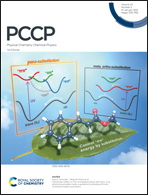Radiation-induced effects on the extraction properties of hexa-n-octylnitrilo-triacetamide (HONTA) complexes of americium and europium†
Abstract
The candidate An(III)/Ln(III) separation ligand hexa-n-octylnitrilo-triacetamide (HONTA) was irradiated under envisioned SELECT (Solvent Extraction from Liquid waste using Extractants of CHON-type for Transmutation) process conditions (n-dodecane/0.1 M HNO3) using a solvent test loop in conjunction with cobalt-60 gamma irradiation. The extent of HONTA radiolysis and complementary degradation product formation was quantified by HPLC-ESI-MS/MS. Further, the impact of HONTA radiolysis on process performance was evaluated by measuring the change in 243Am and 154Eu distribution ratios as a function of absorbed gamma dose. HONTA was found to decay exponentially with increasing dose, affording a dose coefficient of d = (4.48 ± 0.19) × 10−3 kGy−1. Multiple degradation products were detected by HPLC-ESI-MS/MS with dioctylamine being the dominant quantifiable species. Both 243Am and 154Eu distribution ratios exhibited an induction period of ∼70 kGy for extraction (0.1 M HNO3) and back-extraction (4.0 M HNO3) conditions, after which both values decreased with absorbed dose. The decrease in distribution ratios was attributed to a combination of the destruction of HONTA and ingrowth of dioctylamine, which is capable of interfering in metal ion complexation. The loss of HONTA with absorbed gamma dose was predominantly attributed to its reaction with the n-dodecane radical cation (R˙+). These R˙+ reaction kinetics were measured for HONTA and its 241Am and 154Eu complexes using picosecond pulsed electron radiolysis techniques. All three second-order rate coefficients (k) were essentially diffusion limited in n-dodecane indicating a significant reaction pathway: k(HONTA + R˙+) = (7.6 ± 0.8) × 109 M−1 s−1, k(Am(HONTA)2 + R˙+) = (7.1 ± 0.7) × 1010 M−1 s−1, and k(Eu(HONTA)2 + R˙+) = (9.5 ± 0.5) × 1010 M−1 s−1. HONTA-metal ion complexation afforded an order-of-magnitude increase in rate coefficient. Nanosecond time-resolved measurements showed that both direct and indirect HONTA radiolysis yielded the short-lived (<100 ns) HONTA radical cation and a second long-lived (μs) species identified as the HONTA triplet excited state. The latter was confirmed by a series of oxygen quenching picosecond pulsed electron measurements, affording a quenching rate coefficient of k(3[HONTA]* + O2) = 2.2 × 108 M−1 s−1. Overall, both the HONTA radical cation and triplet excited state are important precursors to the suite of measured HONTA degradation products.



 Please wait while we load your content...
Please wait while we load your content...